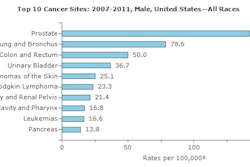Oropharyngeal (OP) cancer is the second most-diagnosed of cancers associated with the human papillomavirus (HPV), according to a new report from the Centers for Disease Control and Prevention (CDC).
A CDC analysis of 2004 to 2008 data from the National Program of Cancer Registries showed that OP is second only to cervical cancer in HPV-associated cancers diagnosed in 50 states and the District of Columbia, according to the April 20 issue of the CDC's Morbidity and Mortality Weekly Report.
An average of 11,726 cases of OP cancer were diagnosed annually, with 63% attributable to HPV infection, the CDC said. Males were diagnosed with OP cancer four times more than females (9,356 cases versus 2,370 cases). For both sexes, the rate of OP cancer was higher among whites (males: 6.4, females: 1.4) and blacks (males: 6.3, females: 1.4) than other races.
Approximately 26,000 new cancers attributable to HPV occur each year: 18,000 among females and 8,000 among males, including an estimated 11,500 cervical cancers and 7,400 OP cancers, the CDC found.
Inclusion of OP cancers as HPV-associated was limited to specific sites where HPV is most likely to be found: base of tongue, tonsils, and "other oropharynx," the report said.
Two vaccines (bivalent and quadrivalent) are available to protect against HPV 16 and 18, the types that cause most cervical and other anogenital cancers, as well as some OP cancers, the report noted.



















